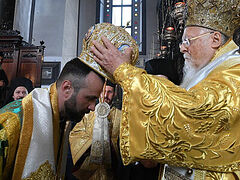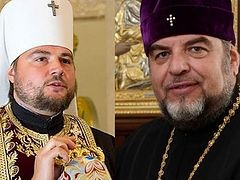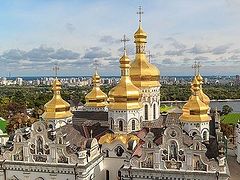Kiev, November 24, 2020
 Formerly-canonical Alexander Drabinko gives Met. Vladimir of Kiev’s vestments to Constantinople’s Ukrainian Exarch. Photo: Facebook
Formerly-canonical Alexander Drabinko gives Met. Vladimir of Kiev’s vestments to Constantinople’s Ukrainian Exarch. Photo: Facebook
On the occasion of what would have been the 85th birthday of His Beatitude Vladimir of Kiev and All Ukraine, the previous primate of the canonical Ukrainian Orthodox Church (UOC), the Patriarch of Constantinople’s new Exarch bishop serving in Ukraine was gifted a set of vestments that had belonged to the ever-memorable Ukrainian primate.
Following the Liturgy in the Cathedral of the Transfiguration in Kiev of the schismatic “Orthodox Church of Ukraine” (OCU) yesterday, which was broadcast on the cathedral’s Facebook page, Alexander Drabinko, a former metropolitan of the canonical UOC, said that he gave the vestments to the newly-consecrated Bp. Michael so he could be vested “in that grace-filled power that His Beatitude wielded in his leadership of the Church of Christ.”
Recall that Drabinko left this Church of Christ that Met. Vladimir led in order to join the OCU that was created by Petro Poroshenko and Patriarch Bartholomew in December 2018 (and has even called for the Church of Met. Vladimir to be banned in Ukraine). He has also gifted episcopal Panagias belonging to Met. Vladimir to Uniates and the schismatic primate Epiphany Dumenko, despite Met. Vladimir’s own firm stance that the creation of multiple overlapping jurisdictions in Ukraine would never heal the schism.
This gift to Constantinople’s representative, who serves on the territory of the UOC without the required blessing of Met. Onuphry, comes against the background of significantly increased activity as of late from Drabinko and Simeon Shostatsky, the only other hierarch to abandon the UOC for the schismatic OCU together with Drabinko.
Shostatsky had hopes of being chosen as the primate of the OCU at the “unification council” in December 2018, with the backing of Petro Poroshenko and Pat. Bartholomew who reasoned that the OCU would be more palatable to the Local Orthodox Churches if led by a hierarch with a true Orthodox consecration. However, the elderly “Patriarch” Philaret Denisenko outmaneuvered them and ensured that his protégé Epiphany Dumenko became primate (though in the end, Philaret himself was sidelined and overshadowed by his protégé).
Thus, Shostatsky traded his position in the recognized canonical UOC for a significantly smaller diocese in the unrecognized OCU. Drabinko has touted himself and Shostatsky as the canonical foundation for the OCU, having come from the canonical UOC, though it has not translated into any more authority or prestige for him.
While Drabinko has turned to media and social media outlets to put himself back in the spotlight, Shostatsky has been busy traveling to visit clergy throughout Ukraine. In particular, he visited the Volyn Province in northwestern Ukraine in October, where he held a number of consultations and negotiations, reports the Orthodox analytical Telegram channel Pravblog.
In addition to improving their own statuses, the former metropolitans increased activity is also aimed at creating conditions for the growth of Constantinople’s Exarchate in Ukraine. At present, the Exarchate consists only of St. Andrew’s Cathedral in Kiev, transferred to the Patriarchate by the government under Poroshenko. However, Constantinople has not forgotten that Poroshenko promised another more than 30 churches and monasteries.
Despite the physical and kangaroo court seizure of UOC churches, the OCU is not growing, and thus the focus has shifted to creating a “more acceptable platform” for the desired outflow of faithful from the canonical UOC. “It is clear that the Phanar’s Exarchate in Ukraine will be presented as such,” writes Pravblog.
Just as they hoped a number of bishops would abandon the UOC in favor of the OCU, they are now hoping for the same in favor of the Exarchate. Thus “dioceses” could be formed within the Exarchate and begin working to siphon clergy and believers from the UOC.
Negotiations are underway with a number of UOC bishops already, according to Pravblog’s sources. However, as it is unlikely that ruling bishops will give up their stable positions to join the largely-unrecognized OCU, Drabinko and Shostatsky are focusing on retired and vicar bishops who could be tempted with the offer of more authority in the Exarchate. One bishop in particular, Archbishop Panteleimon of Bucha, is said to have close relations with Shostatsky.
And while Constantinople created and granted autocephaly to the OCU, touting itself as the loving mother of the Ukrainian people, the development of its Exarchate in Ukraine would pose a threat not only to the Moscow Patriarchate’s UOC, but to the OCU as well. It is no secret that many in the OCU are disappointed with its stalled growth and dissatisfied with the policies and decisions of Epiphany Dumenko.
With the expansion of its Exarchate, Constantinople could maintain a foothold in Ukraine, regardless of any political changes, whether in favor of or against the OCU. And as Pravblog suggests, it is not out of the question that the Exarchate could eventually absorb the OCU.
RIA-Novosti also reports on the situation in terms of the threat it poses to the OCU.
Pat. Bartholomew recently met with Secretary of State Mike Pompeo who declared that Constantinople is the head of the Orthodox Church and a “key partner” of the United States, including in the “champion[ing of] religious freedom.”
“And there is no doubt that the Phanar will help inculcate American religious values, including in Ukraine,” writes RIA-Novosti.
In recent statements, Pat. Bartholomew has referred to the flock of the UOC as “ungrateful children” and openly declared that he only temporarily tolerates the presence of Met. Onuphry and the other hierarchs of the canonical UOC in Ukraine.
A month before Pompeo’s visit to Turkey, Ukrainian President Vladimir Zelensky also made the trip. While in his first visit to the Phanar last year he managed to maintain his neutral stance towards religious affairs in Ukraine and refused to sign an agreement to uphold Poroshenko’s promise to give numerous Church properties to Constantinople, this second trip was more positive for Constantinople, though concerning for the faithful of the Ukrainian Church who only recently came out from under the persecuting hand of Poroshenko.
Poroshenko had also promised Constantinople to sway a number of canonical UOC bishops to join the OCU, though he failed to keep that promise as well. As the only bishops of the schismatic OCU who enjoy a canonical consecration, Drabinko and Shostatsky may consider themselves of an elite status, as Drabinko has noted, it nevertheless has left them more or less isolated within the OCU.
Drabinko was present at the consecration of Constantinople’s new Exarch, for which he was criticized by his fellow hierarchs in the OCU, RIA-Novosti reports. After all, they well understood the threat of a developing Exarchate in what is supposed to be their territory.
And while the Exarchate is officially designed to feed the Orthodox Greeks on the territory of Ukraine, Constantinople in fact chose a native Ukrainian to make the transfer of Church properties to it more likely and to get physically closer to the OCU to increase its control over it, believes Ukrainian Orthodox historian Vladislav Petrushko.
Recall that the tomos granted to the OCU already stipulates that Constantinople maintains key points of control in the OCU.
“Now the control will be strengthened. In general, the boundaries between the structures are blurred. The Phanar, in fact, is absorbing the OCU,” Petrushko strongly believes.
It was this semi-independent status of the OCU in part that led to its internal schism, with Philaret Denisenko departing to revive his schismatic “Kiev Patriarchate.”
Against of all this background, the purpose of Drabinko’s doting upon the Constantinople representative in Ukraine becomes clearer.
Follow us on Facebook, Twitter, Vkontakte, Telegram, and WhatsApp!




